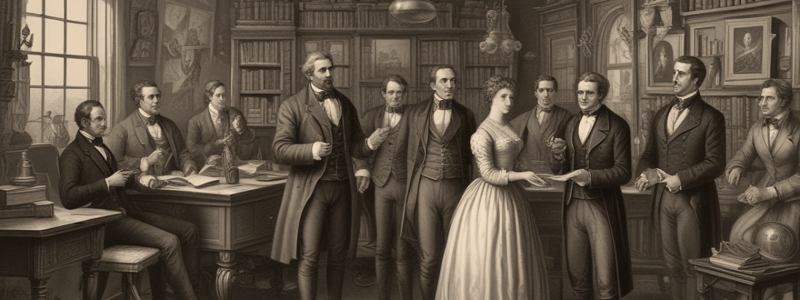Podcast
Questions and Answers
What was a major obstacle that prevented poor youths from accessing formal education?
What was a major obstacle that prevented poor youths from accessing formal education?
- Their families' desperate financial state (correct)
- Lack of interest in education
- Limited availability of educational institutions
- Discrimination based on social class
What was the primary purpose of institutions like the House of Refuge in New York City?
What was the primary purpose of institutions like the House of Refuge in New York City?
- To educate and simultaneously indenture poor children (correct)
- To provide vocational training to poor children
- To offer temporary shelter to homeless youths
- To reform juvenile delinquents through punishment
What skills did Sylvester Lusk's farm in Enfield, Connecticut, aim to teach to boys and girls, respectively?
What skills did Sylvester Lusk's farm in Enfield, Connecticut, aim to teach to boys and girls, respectively?
- Farming and housekeeping, respectively
- The trade and mystery of farming and housewifery, respectively (correct)
- Agriculture and domestic labor, respectively
- Farming and textile manufacturing, respectively
In exchange for their labor, what did apprentices like those at Sylvester Lusk's farm receive?
In exchange for their labor, what did apprentices like those at Sylvester Lusk's farm receive?
What type of industry did Samuel Slater's textile mills in southern New England represent?
What type of industry did Samuel Slater's textile mills in southern New England represent?
According to the newspaper advertisement, what was the age range sought by Samuel Slater for his textile mill apprentices?
According to the newspaper advertisement, what was the age range sought by Samuel Slater for his textile mill apprentices?
Study Notes
Middle-Class and Poor Youths' Education and Employment
- Middle-class youths had opportunities for respectable employment through formal education.
- Poor youths, however, remained in marginalized positions due to their families' financial struggles.
- Pauper children who received education through institutions like the House of Refuge in New York City were often indentured to successful families as field hands or domestic laborers.
Indentures and Apprenticeships
- The Society for the Reformation of Juvenile Delinquents in New York City sent its wards to places like Sylvester Lusk's farm in Enfield, Connecticut.
- Lusk's farm provided boys with training in "the trade and mystery of farming" and girls with training in "the trade and mystery of housewifery".
- In exchange for providing apprentices with basic necessities like food, clothing, and education, they promised obedience, morality, and loyalty.
Factory Work
- Poor children also found work in factories, such as Samuel Slater's textile mills in southern New England.
- Slater published a newspaper advertisement in 1794 seeking "four or five active Lads, about 15 Years of Age to serve as Apprentices in the Cotton Factory".
Studying That Suits You
Use AI to generate personalized quizzes and flashcards to suit your learning preferences.
Description
This quiz explores the opportunities for education and employment among middle-class and poor youths in 19th century America, highlighting the disparities in their experiences.




